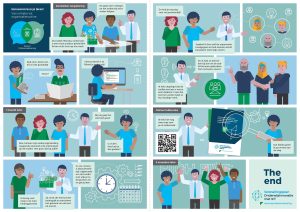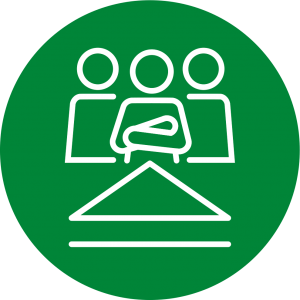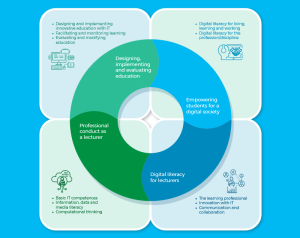
Implementing educational innovations in higher education: from initiation to organizational routine
Educational innovation using ICT has been a priority in higher education for years, due to its impact on the quality


Why not deal creatively with the challenges of the COVID-19 crisis? That was the approach of Kees Ritmeester, innovation programme manager at Driestar Christian University for Teaching Education in Gouda. From online linking students with a study delay to deploying interns at affected primary schools.
 “Driestar offers various courses, seven second-grade teacher training courses and pedagogy training. Due to the pandemic, internships were halted or were given a different form,” Kees reflects. “In the meantime, schools were struggling with children with learning difficulties and sick teachers. Can’t we use our students to help these schools? We did. In the last month of the academic year, our students immediately went on an internship for four weeks. We shifted this to the last week of this academic year.”
“Driestar offers various courses, seven second-grade teacher training courses and pedagogy training. Due to the pandemic, internships were halted or were given a different form,” Kees reflects. “In the meantime, schools were struggling with children with learning difficulties and sick teachers. Can’t we use our students to help these schools? We did. In the last month of the academic year, our students immediately went on an internship for four weeks. We shifted this to the last week of this academic year.”
The space to think about this in a creative way only came after the transition to online went smoothly. First, every effort had to be made to make this transition possible. It started with a small crisis team, consisting of the Executive Board, people from the facility service, communication and education. A second ring with the management team and implementers was formed around it. “Of course we did some online, but that was relatively little. We drew up the frameworks and the teachers gave substance to them themselves. On Friday the final decision was taken on the physical closure of the schools, on Tuesday evening we were with the first groups together, and we started online and the entire organisation had shifted by Wednesday.”
It was a rigorous step, in which a strong focus was placed on the support of teachers, he says. “Everyone got real-time help, even if you were lecturing 5 minutes in advance or even in class.” Consultation hours were organised by education specialists and people who mastered the technology. The aim: to help teachers master the technique. Sometimes up to 60 teachers came knocking. “If someone had a good idea, I asked them to share it with all our colleagues in the next ‘inspiration hour. So the teachers could also train each other. I thought that was fantastic about the first phase. And I have rarely experienced that before: the collegial networks that suddenly arose. You really need each other.”
After that first month, which was packed with instructions, a period followed where there was room for support and deepening. “After only a week and a half, together with our research center, we sent questionnaires to colleagues, to see where their real needs were. We noticed they were looking for more didactic knowledge. That is why we came up with a didactic online team. Together they discussed which new working methods there were, how we could also provide this customized support.” Just before the summer holidays, the phase of assurance and inspiration began, focusing even further on online didactics.
But in the meantime there were also other kinds of challenges. Teacher training students could no longer do an internship. The curriculum planning had to be overhauled. What now? “We soon realised that this situation was going to take a long time. We started a WHY project, with the question: What do we stand for as a study program? How can we equip our teachers as well as possible, while also looking at the work field? Because complete online education has never been our ideal. We want a smart form of blended learning, in which personal meeting is central, in which you connect the real, physical meeting and the online meeting and shape them into a kind of optimal mix. That didn’t work now. After a lapse of 2 or 3 weeks, many teachers said to me ‘I didn’t become a teacher for this.’ I do want to look the student in the eye with some regularity from time to time.”
Schedules were set up in such a way that each student could come to college for one or two days. It is true in small groups of 12 students, with online lessons the other days. But it was still possible to work on a better blended form. The internships were able to take place again, but from a different starting point: to support the schools that were affected by the dropout of teachers due to the corona crisis.
To inspire each other in a creative way, teachers regularly share great examples in team sessions. From interaction with students to redesigning the exam in a new way. But new insights in the field of student supervision are also discussed. “We had a group of students who were in danger of dropping out. Those students came from different grades and from different groups. We then linked them together in small groups, in a ‘study boost group’. They started the day together, shared study programmes. Stayed in close contact with each other. The students helped each other study online! I thought that was a fantastic experience.”
Interview: Hester Otter
This is part 5 in a series of a total of 7 interviews with participants in the Professional development zone. In the interviews, they share practical experience and inspiration for supporting teachers in educational innovation with ICT.
Provide connection. A powerful way to do this is by sharing best practicesand experiences. We start the week with a week opening. We have now supplemented this with contributions from various organisational units. From the executive board, managers, support, to educational advisers, and teachers.
Share this page

Educational innovation using ICT has been a priority in higher education for years, due to its impact on the quality

Blended learning. A concept that is high on the agenda in education land. Are you working on blended learning within

Making optimal use of the possibilities of IT in higher education requires new knowledge and skills from lecturers. As a

Do you want to know which digital competences of lecturers are relevant for educational innovation with IT? Then get to